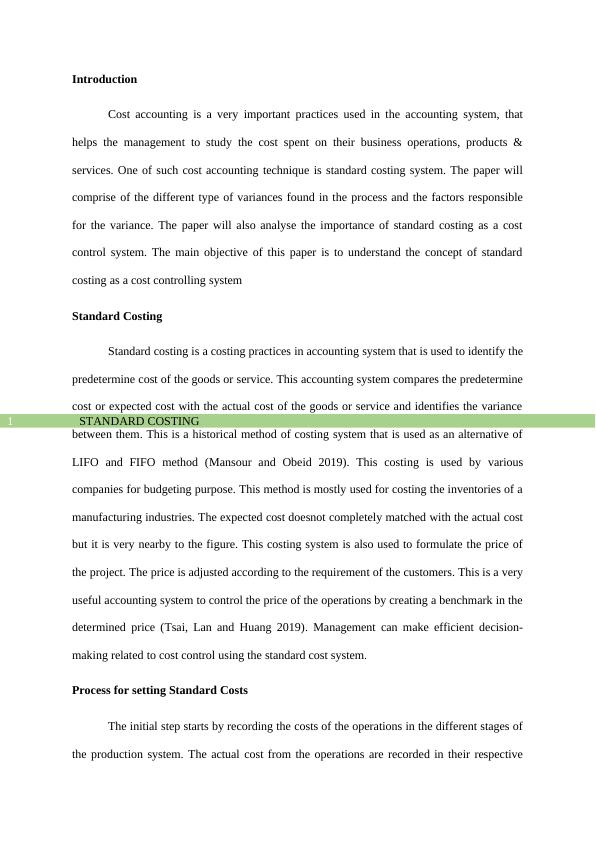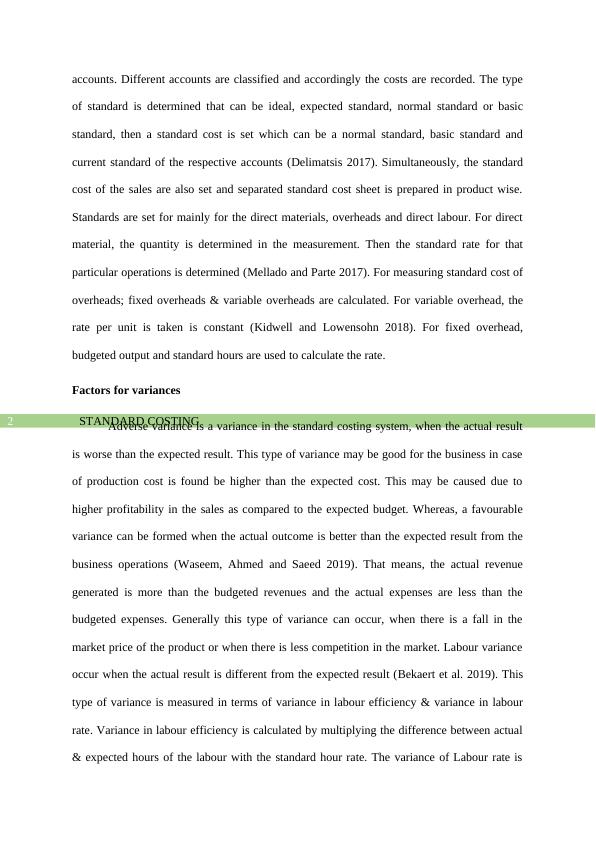Standard Costing as a Cost Controlling System
Added on 2022-08-17
8 Pages2182 Words13 Views
Running Head: STANDARD COSTING
STANDARD COSTING
Name of the Student
Name of the University
Author Note
STANDARD COSTING
Name of the Student
Name of the University
Author Note

STANDARD COSTING1
Introduction
Cost accounting is a very important practices used in the accounting system, that
helps the management to study the cost spent on their business operations, products &
services. One of such cost accounting technique is standard costing system. The paper will
comprise of the different type of variances found in the process and the factors responsible
for the variance. The paper will also analyse the importance of standard costing as a cost
control system. The main objective of this paper is to understand the concept of standard
costing as a cost controlling system
Standard Costing
Standard costing is a costing practices in accounting system that is used to identify the
predetermine cost of the goods or service. This accounting system compares the predetermine
cost or expected cost with the actual cost of the goods or service and identifies the variance
between them. This is a historical method of costing system that is used as an alternative of
LIFO and FIFO method (Mansour and Obeid 2019). This costing is used by various
companies for budgeting purpose. This method is mostly used for costing the inventories of a
manufacturing industries. The expected cost doesnot completely matched with the actual cost
but it is very nearby to the figure. This costing system is also used to formulate the price of
the project. The price is adjusted according to the requirement of the customers. This is a very
useful accounting system to control the price of the operations by creating a benchmark in the
determined price (Tsai, Lan and Huang 2019). Management can make efficient decision-
making related to cost control using the standard cost system.
Process for setting Standard Costs
The initial step starts by recording the costs of the operations in the different stages of
the production system. The actual cost from the operations are recorded in their respective
Introduction
Cost accounting is a very important practices used in the accounting system, that
helps the management to study the cost spent on their business operations, products &
services. One of such cost accounting technique is standard costing system. The paper will
comprise of the different type of variances found in the process and the factors responsible
for the variance. The paper will also analyse the importance of standard costing as a cost
control system. The main objective of this paper is to understand the concept of standard
costing as a cost controlling system
Standard Costing
Standard costing is a costing practices in accounting system that is used to identify the
predetermine cost of the goods or service. This accounting system compares the predetermine
cost or expected cost with the actual cost of the goods or service and identifies the variance
between them. This is a historical method of costing system that is used as an alternative of
LIFO and FIFO method (Mansour and Obeid 2019). This costing is used by various
companies for budgeting purpose. This method is mostly used for costing the inventories of a
manufacturing industries. The expected cost doesnot completely matched with the actual cost
but it is very nearby to the figure. This costing system is also used to formulate the price of
the project. The price is adjusted according to the requirement of the customers. This is a very
useful accounting system to control the price of the operations by creating a benchmark in the
determined price (Tsai, Lan and Huang 2019). Management can make efficient decision-
making related to cost control using the standard cost system.
Process for setting Standard Costs
The initial step starts by recording the costs of the operations in the different stages of
the production system. The actual cost from the operations are recorded in their respective

STANDARD COSTING2
accounts. Different accounts are classified and accordingly the costs are recorded. The type
of standard is determined that can be ideal, expected standard, normal standard or basic
standard, then a standard cost is set which can be a normal standard, basic standard and
current standard of the respective accounts (Delimatsis 2017). Simultaneously, the standard
cost of the sales are also set and separated standard cost sheet is prepared in product wise.
Standards are set for mainly for the direct materials, overheads and direct labour. For direct
material, the quantity is determined in the measurement. Then the standard rate for that
particular operations is determined (Mellado and Parte 2017). For measuring standard cost of
overheads; fixed overheads & variable overheads are calculated. For variable overhead, the
rate per unit is taken is constant (Kidwell and Lowensohn 2018). For fixed overhead,
budgeted output and standard hours are used to calculate the rate.
Factors for variances
Adverse variance is a variance in the standard costing system, when the actual result
is worse than the expected result. This type of variance may be good for the business in case
of production cost is found be higher than the expected cost. This may be caused due to
higher profitability in the sales as compared to the expected budget. Whereas, a favourable
variance can be formed when the actual outcome is better than the expected result from the
business operations (Waseem, Ahmed and Saeed 2019). That means, the actual revenue
generated is more than the budgeted revenues and the actual expenses are less than the
budgeted expenses. Generally this type of variance can occur, when there is a fall in the
market price of the product or when there is less competition in the market. Labour variance
occur when the actual result is different from the expected result (Bekaert et al. 2019). This
type of variance is measured in terms of variance in labour efficiency & variance in labour
rate. Variance in labour efficiency is calculated by multiplying the difference between actual
& expected hours of the labour with the standard hour rate. The variance of Labour rate is
accounts. Different accounts are classified and accordingly the costs are recorded. The type
of standard is determined that can be ideal, expected standard, normal standard or basic
standard, then a standard cost is set which can be a normal standard, basic standard and
current standard of the respective accounts (Delimatsis 2017). Simultaneously, the standard
cost of the sales are also set and separated standard cost sheet is prepared in product wise.
Standards are set for mainly for the direct materials, overheads and direct labour. For direct
material, the quantity is determined in the measurement. Then the standard rate for that
particular operations is determined (Mellado and Parte 2017). For measuring standard cost of
overheads; fixed overheads & variable overheads are calculated. For variable overhead, the
rate per unit is taken is constant (Kidwell and Lowensohn 2018). For fixed overhead,
budgeted output and standard hours are used to calculate the rate.
Factors for variances
Adverse variance is a variance in the standard costing system, when the actual result
is worse than the expected result. This type of variance may be good for the business in case
of production cost is found be higher than the expected cost. This may be caused due to
higher profitability in the sales as compared to the expected budget. Whereas, a favourable
variance can be formed when the actual outcome is better than the expected result from the
business operations (Waseem, Ahmed and Saeed 2019). That means, the actual revenue
generated is more than the budgeted revenues and the actual expenses are less than the
budgeted expenses. Generally this type of variance can occur, when there is a fall in the
market price of the product or when there is less competition in the market. Labour variance
occur when the actual result is different from the expected result (Bekaert et al. 2019). This
type of variance is measured in terms of variance in labour efficiency & variance in labour
rate. Variance in labour efficiency is calculated by multiplying the difference between actual
& expected hours of the labour with the standard hour rate. The variance of Labour rate is

End of preview
Want to access all the pages? Upload your documents or become a member.
Related Documents
Cost Accounting & Costing Methods | Assignmentlg...
|8
|2001
|82
Standard and Target Costinglg...
|14
|4038
|19
Benefits of Budgeting, Budgeted Income Statement, Variance Analysis, Cost Estimation and Activity Based Costinglg...
|6
|935
|344
Managerial Aspect Of Standard And Target Costinglg...
|17
|4793
|12
Standard Costing: Types, Advantages, and Variance Analysislg...
|13
|2849
|397
Cost and Variance Analysis for Deskliblg...
|5
|566
|463
